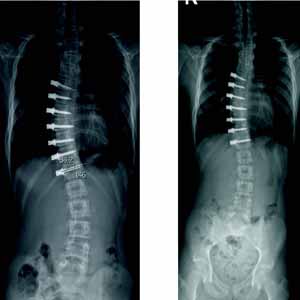Anterior vertebral body tethering as a treatment for scoliosis in skeletally immature patients

Published: 28 October 2022
Abstract Views: 1404
PDF: 369
Publisher's note
All claims expressed in this article are solely those of the authors and do not necessarily represent those of their affiliated organizations, or those of the publisher, the editors and the reviewers. Any product that may be evaluated in this article or claim that may be made by its manufacturer is not guaranteed or endorsed by the publisher.
All claims expressed in this article are solely those of the authors and do not necessarily represent those of their affiliated organizations, or those of the publisher, the editors and the reviewers. Any product that may be evaluated in this article or claim that may be made by its manufacturer is not guaranteed or endorsed by the publisher.
Similar Articles
- Massimo Agosti, Francesco Tandoi, Laura Morlacchi, Angela Bossi, Nutritional and metabolic programming during the first thousand days of life , La Pediatria Medica e Chirurgica: Vol. 39 No. 2 (2017)
- Mario Lima, Tommaso Gargano, Giovanni Ruggeri, Francesca Destro, Michela Maffi, Laparoscopic treatment of congenital choledochal cyst and hepaticojejunostomy with extracorporeal Roux-en-Y anastomosis: technical aspects and early experience with three cases , La Pediatria Medica e Chirurgica: Vol. 38 No. 2 (2016)
- Sara Ugolini, Lorenzo Tofani, Elisa Zolpi, Louise Montalva, Cosimo Lotti, Antonino Morabito, Fabio Chiarenza, Arnaud Bonnard, Morbidity related to major lung thoracoscopic resections in children , La Pediatria Medica e Chirurgica: Vol. 46 No. 2 (2024)
- Roberta Barachetti, Elisabetta Villa, Mario Barbarini, Weaning and complementary feeding in preterm infants: management, timing and health outcome , La Pediatria Medica e Chirurgica: Vol. 39 No. 4 (2017)
- Elisa Cerchia, Carmine Noviello, Giovanni Torino, Edoardo Bindi, Francesca Mariscoli, Giovanni Cobellis, Thoracoscopic excision of asymptomatic antenatally diagnosed mediastinal bronchogenic cysts: A case report , La Pediatria Medica e Chirurgica: Vol. 43 No. 2 (2021)
- Enrica Caponcelli, Milena Meroni, Giulia Brisighelli, Claudia Rendeli, Emanuele Ausili, Piergiorgio Gamba, Antonio Marte, Barbara Daniela Iacobelli, Laura Lombardi, Ernesto Leva, Paola Midrio, Transanal irrigation (TAI) in the paediatric population: Literature review and consensus of an Italian multicentre working group , La Pediatria Medica e Chirurgica: Vol. 43 No. 1 (2021)
- Rose Nirwana Handayani, Defi Efendi, The impact of multiple insertions on peripheral intravenous access in low-birth-weight infants in perinatology , La Pediatria Medica e Chirurgica: Vol. 43 No. s1 (2021)
- Agostino Berio, Attilia Piazzi, Carlo Enrico Traverso, Kearns-Sayre syndrome with facial and white matter extensive involvement: a (mitochondrial and nuclear gene related?) neurocristopathy? , La Pediatria Medica e Chirurgica: Vol. 39 No. 4 (2017)
- Luisella Pedrotti, Barbara Bertani, Gabriella Tuvo, Redento Mora, Luca Marin, Federica De Rosa, Achilles tendon surgery in clubfoot: Are long term sequelae predictable? , La Pediatria Medica e Chirurgica: Vol. 44 No. 1 (2022)
- Assunta Turco, Mariapina Cerulo, Fulvia Del Conte, Vincenzo Coppola, Giovanni Severino, Maria Escolino, Ciro Esposito, Correlation between FLACC scale score and analgesic requirement in children undergoing minimally invasive surgery , La Pediatria Medica e Chirurgica: Vol. 45 No. 1 (2023)
You may also start an advanced similarity search for this article.

 https://doi.org/10.4081/pmc.2022.291
https://doi.org/10.4081/pmc.2022.291




